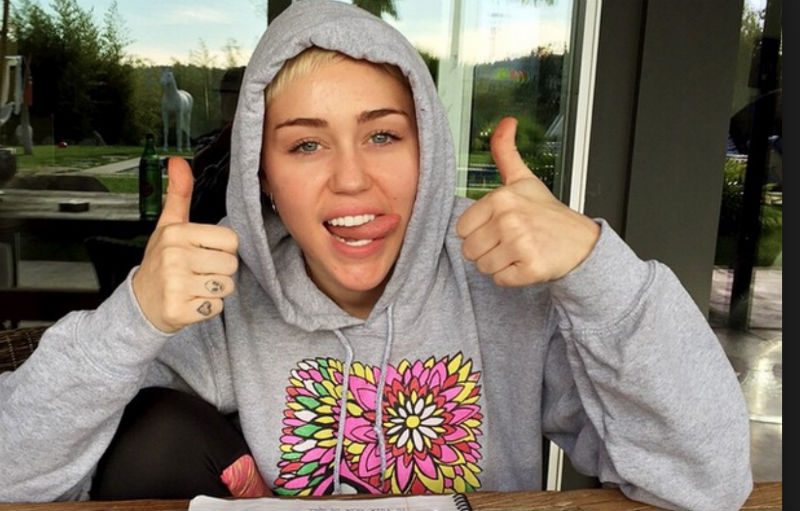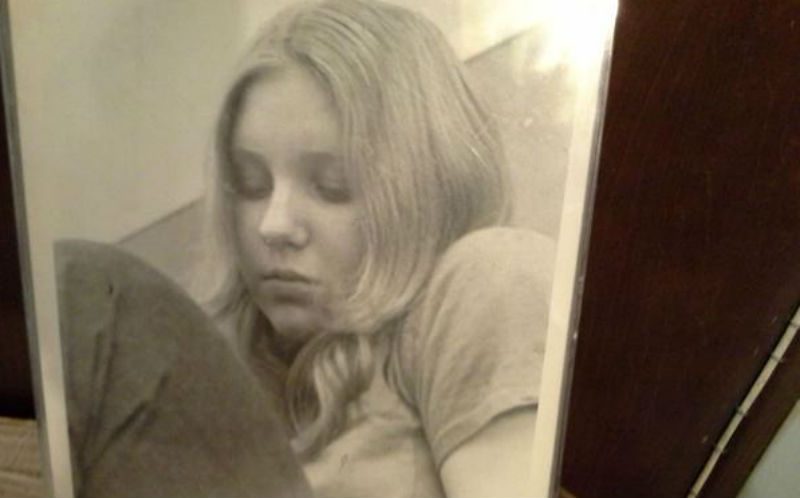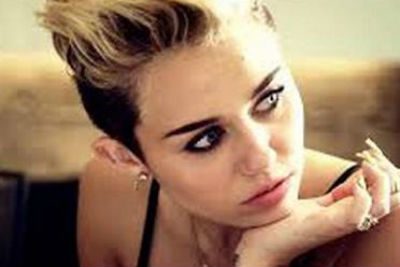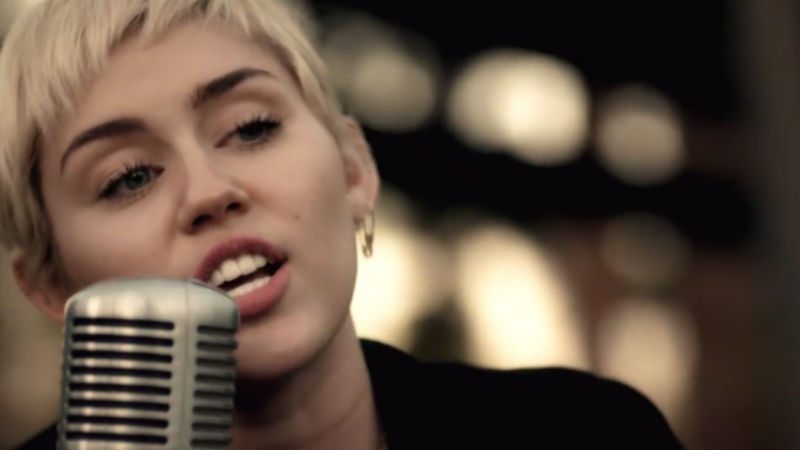LGBT People Are Committing Suicide, So We Need Celebrity Voices
She’s one of those celebrities who people love to diss. Especially people significantly older and less talented than she is.
So unsurprisingly, Miley Cyrus has gotten big thumbs down in much of the media for her declaration last week–after establishing a non-profit organization–that she’s not straight. Salon’s headline “How impressed should we be with celebrities like Miley Cyrus who risk nothing by coming out?” even suggested that her revelation was a publicity grab.
Salon asserted, “Miley Cyrus will probably only see her own fame grow in the wake of her coming out, with higher-charting singles and increased album downloads as people rush to embrace her non-threatening, pop-friendly display of diversity. Furthermore, Cyrus’ personal journey will now be tinctured with an air of righteousness thanks to her foundation’s efforts.”
Really?
Last I looked, homophobia was still a thing–as snarky, vituperatively anti-gay comments like this underscore. Being LGBT doesn’t proffer privilege. Just ask anyone who is.
Yes. That’s called female oppression and it’s driving many girls to self-harm, obesity, anorexia, bulimia and unprotected sex.
Miley’s discomfort with labels was part of what prompted her to found her nonprofit organization, The Happy Hippie Foundation states, “Our mission is to rally young people to fight injustice facing homeless youth, LGBT youth and other vulnerable populations.” The website also states, “Everyone deserves a safe place to call their home and the chance to make their dreams a reality,” and it cites a series of grim stats about the impact of homophobia, lesbophobia and transphobia on LGBT teens.
HHF also notes, “By supporting strategic programs that focus on prevention, immediate needs and awareness, we can change these numbers.”
Miley is 22. She’s using the power of her public voice to help kids she says are “like myself”–young people who know they aren’t straight but fear what can happen if they come out. Especially if their parents aren’t accepting, liberal, pro-LGBT people.

The stats HHF cites are real. And they translate into actual people–boys and girls and trans teens who don’t know where to turn or what to do when they discover they aren’t like everyone else.
I was one of those teens. I came out in high school–or rather, I was outed and expelled from my all girl’s high school for being a lesbian. My then-girlfriend’s mother had found letters we had exchanged. One afternoon she came to the school and picked up my girlfriend. I went back to the house with them.
Spread out on the coffee table and dining room table in the meticulously kept row home in a working-class neighborhood in Philadelphia were my letters, small gifts I had given her. A couple of lesbian pulp novels I had purloined from a hidden bookshelf at the home of someone I babysat for. Some Polaroids of the two of us. Some Joni Mitchell and Laura Nyro albums.
It was all teenage stuff. Nothing dramatic. Nothing sexual. All very first-love. My girlfriend was 16, I was 15. We were both students at one of the most elite public schools in the city, a school for girls that were academically gifted. A school that my mother and grandmother had both attended and at which my sister was a freshman. A school I had been told since I was six I would be attending.
A school I had had to take a three-hour test to get into. A school that had been a breath of air for me, coming from the claustrophobic Catholic girls school I had grown up in.
Later that night my parents got a call from my girlfriend’s parents. The next day I went to school (after a horrible night of screaming and fighting with my parents) to find the words DYKE and LEZBO scrawled on my locker in marker.
How did they know?
I don’t remember exactly how much time passed between the incident with my girlfriend’s mother and my being told I had to see the principal and that one of my parents must come as well. A few days? A week?
It seemed like both no time at all and endless waiting for something else to happen. But when it did happen, when I was sitting in the principal’s office–a slender, petite and elegant woman with Dr. before her name–with my father sitting next to me, it was the most difficult thing I could remember facing.
My father pleaded my case, invoking my mother, who had graduated first in her class with a language scholarship to Wellesley College, one of the best colleges in the country and one of the Seven Sisters colleges that were the women’s side of the Ivy League. He invoked my grandmother and my sister and the importance of a family tradition. He said he was certain it was just a phase because, as he had said to me the night my girlfriend’s father had called him, “She’s pretty and boys like her.”
But I was, the principal said, a “bad moral influence” on the hundreds of other girls at the school. I was out. Forever.
My girlfriend’s mother had called the principal and had told her that I had seduced her daughter. That I was dangerous. That I might do it to other girls, too.

That wasn’t how it happened. I had actually been seduced by a different girl. There were a lot of seductions at my school. There were lesbian teachers there at the school who had been there since my mother was a student there. There were many other lesbian students at the school. I knew a lot of them.
But I was the only one who had been outed.
So I had to go.
It was winter. I was grounded while my parents considered what to do with me–what kind of school would take me.I stayed in my room, alone, reading, writing, listening to music. And thinking about death as I recited Sylvia Plath poems under my breath in the dark.
I’m not sure how long I had been cutting myself before being expelled from high school. Since sixth grade? Maybe before then. The little stack of razor blades taken from my father’s pack were wrapped in tissue paper. Black with blue edges, they sliced cleanly and neatly through the soft, pale skin of my inner arms and my inner thighs. The rush of blood was like a pressure valve being released. I didn’t know anything about endorphins in those days, but that’s what I was doing to myself–self-medicating with endorphin release.
The scars are still there, decades later. But muted. Like the pain of that time.
I wasn’t really thinking about killing myself that day, not long after being expelled and having my entire world close down around me. Not long after I was labeled a dyke, a lezbo, in those years soon after Stonewall when being lesbian or gay was less of a secret, but not less freakish.
I stood over the bathroom sink with the razor and ran it down my arm like always. I just needed to be released from the pain. I needed a way out.
So when the skin spread wide, wider, widest and the blood rushed hard and fast from my right arm, I wasn’t quite prepared for it. The scream was short and more one of surprise than of pain.
The doctors who sewed up my arm didn’t bother to ask me what happened. All the other scars were there. They knew where to look for more. And found them.
The psychiatric facility was near our house. I had been there just a few months back, to visit a friend–another teenaged lesbian–who had taken all her mother’s Seconal at a New Year’s Eve party. I had saved her life by finding her and getting her to the emergency room where they fed her charcoal and Narcan and she had big black streaks down her face while she cried and told me I should have let her die, why didn’t I let her die. She couldn’t live with herself, knowing what she was.
We talked like that then. In the 1970s. We didn’t know that there was life beyond high school and that grown ups could be lesbians and have decent lives that weren’t spent in hiding and shadows.
I would be at that same psychiatric facility the next year, visiting my-then best friend, another lesbian high-school student, this one from my new school, the one for “troubled” teens. This friend had taken a lesson from me and sliced open both her wrists, hoping to bleed out before being saved.
Me, my friends–that was decades ago. Before there were suicide websites to remind you to cut diagonally, not horizontally, and that lying in a tub of very hot water would speed the bleed. Before there was suicide “contagion”–where one teenager attempts suicide or is successful and a half dozen more follow suit. Before you could buy a 100 Xanax online and be dead before morning. Before you could get a handgun down the street and go into the garage or the woods near your house and just pull the trigger.
It’s hard to be a teenager under the best of circumstances. But if you are “different”–as I was, as my lesbian friends were–it’s ever so much harder. And now the pressures of online bullying and the inescapable and oppressive nature of social media can drive even the most stable kid to contemplate suicide, if not actually follow through.
According to NAMI, the National Alliance on Mental Illness, suicide is the third-leading cause of death for 15 to 24 year olds and the sixth leading cause of death for five to 15 year olds. Between 1980 and 2000, the suicide rate among children aged 10 to 14 years increased by 100%.
So as we discover our pain at a younger age, we are also trying to escape it at a younger age.
About 5,000 teenagers commit suicide each year in the U.S. But only one in 25 attempts is successful. So there are tens of thousands of kids attempting suicide each year–kids like I was or my friends were–but someone finds us in time, or we pick the wrong method.
In 2008, I won the NLGJA (National Lesbian and Gay Journalists Association) Excellence in News Writing Award for my newspaper series [http://www.nlgja.org/blog/2008/09/23/2008-excellence-in-journalism-award-winners/ ] for my series “Killing Ourselves with Hate: Suicide in the LGBT Community,” which I wrote for PGN. The series begins with a gay teenager who threw himself off a highway overpass. If only that had been an anomalous event.
But as I wrote in that series, parents often cover up both a teen’s suicide and the reasons for it. As a consequence, more and more “psychological autopsies” are being performed to get a sense of just how prevalent suicides are among LGBT youth.
Elizabeth “Lizzie” Lowe was only 14 when she hanged herself right before Christmas last year in Manchester, England. She was afraid her devoutly Christian parents wouldn’t be able to cope with her lesbianism.
At the inquest into her death, one friend told the court, “She said she wasn’t sure if they would be okay with it. I told her that I didn’t think it would be like that, but she did not want to tell them.”
It was also revealed at the inquest that Lowe had self-harmed since her realization that she was a lesbian. One friend of Lowe’s told the court that Lizzie had told her that cutting herself was a “coping mechanism.”
Lowe was an honors student, a Girl Scout and a musician in a local orchestra. The court found that she had committed suicide even though she was “a highly intelligent and gifted young woman” because she was “struggling to come to terms with her sexuality.”
It turned out Lowe’s fears of her parents’ reaction were unfounded. They were devastated by her suicide and said, “Lizzie did not make known her struggle with depression and the challenges she tried to face alone as a young adult. We wish she had confided in us because she would have found a wealth of love and acceptance and support. The loss of our precious daughter has left us broken-hearted.”
But Lowe’s parents, sadly, are not the norm. My own parents and those of my two suicidal lesbian high school friends were far less accepting and each of us was put into what is now called “reparative therapy” to turn us straight. It didn’t work on any of us, but the friend who took her mother’s Seconal did attempt suicide again–fortunately also unsuccessfully.
As Miley Cyrus’s HHF notes, many homeless teens are LGBT. Often because they have either left home after their LGBT status is revealed or have been thrown out because of it.
In 2010, I won the Society of Professional Journalists Award for Enterprise (Investigative) reporting for a four-part, months-long series that still haunts me. “Hiding in Plain Sight” took me onto the streets of Philadelphia from late summer through till nearly Christmas. [http://www.epgn.com/news/local/304-737631-hiding-in-plain-sight-homeless-lbgt-teens-our-hidden-minority]
In a city of five million like Philadelphia, there are a lot of homeless people. The ones you don’t see are the teens and young adults. They can’t be distinguished from other teens who seem to just be hanging out at the malls or in the parks, always in groups. At night, though, they are at greatest risk–if they can’t find a friend to crash with, they will find someone else. Almost always an older man, straight or gay, who will give them a place to sleep and a nice meal. But it doesn’t come free.
One girl I met at a youth center was pregnant–with the baby of some man who had given her a place to stay when it was so cold she just had to get warm. Her girlfriend, also homeless, had left her after she found out.
Another young lesbian found it difficult to stay at shelters because she was bullied and accused of coming on to other shelter mates when she changed her clothes–just because she was lesbian.
A young gay African-American already had HIV because he’d been turning tricks since he was 15. I can still see his sweet, dreamy face as he told me about how hard it was to get warm in the winters, cool in the summers. He wanted to go back to school. He wanted to be safe.
These young people were just a few of thousands in my city.
According to the U.S. Census and the National Coalition for the Homeless, 34 percent of the homeless population is young people under 24. Teens 12 to 17 are the most likely of all people to become homeless and the average age for a teen to become homeless is 14 and a half.. According to estimates by the Urban Institute, nearly 1 in 5 youths under the age of 18 will run away at least once. (Nearly every adult lesbian I know ran away at least once when she was living at home. I ran away four times myself.)
Over 50% of people under 20 in shelters and on the streets report that their parents told them to leave or knew they were leaving and did nothing to stop them. This was the case with every teen and young adult I interviewed for my series and every social worker I spoke with said it was the norm. All the young men and women I interviewed had been physically or verbally abused by their families when they revealed they were LGBT.
Another norm is alcohol and drug abuse. And survival sex work. Homeless people overall in the U.S. are nearly ten times as likely to be HIV-infected as the general population.
The Department of Justice estimates that every year, over 1.7 million teens experience homelessness in the US. That’s the same number as the total populations of more than a dozen U.S. states, including Maine, Nebraska, Hawaii, West Virginia, New Hampshire, Delaware, Rhode Island, the Dakotas, Vermont, Wyoming, Idaho, Alaska, Guam and all the territories.
That’s a lot of homeless teens. Four out of every ten of them is LGBT.
Even more disturbing than these stats is the fact that 32 percent of runaway and homeless youth have attempted suicide at some point in their lives. Like me, like my lesbian friends.
We can continue to shrug off these celebrity reveals or we can put them in the context in which they belong–which is that they might be saving lives.
When I was a 15 year old being expelled from high school for no crime other than being lesbian, I knew there were lesbian teachers at my school, that there were other lesbian students, including my girlfriend. But no one stood up for me. No one spoke out and said, “I’m a lesbian, too.” And there were no lesbian singers or actors or writers who were out.
The isolation you feel can be crushing. Even in 2015, there are LGBT teen suicides every month–some, like Lizzie Lowe and trans teen Leelah Alcorn we hear about, many more we do not.
I don’t know how I would have felt at 15 if one of the most visible stars of my high school years had come out and started a non-profit to support teens like me. I don’t know if it would have influenced my parents and teachers. But I know how desperate I was for role models, even if they were the characters in old lesbian pulp fiction novels from my parents’ generation.
Miley Cyrus’s music may not be your fave. But with her 20 million Twitter followers, she’s got the attention of an awful lot of people–including, perhaps, some girls like I was, or my friends were, who are sitting in the bathroom with a bottle of pills or a razor blade or just their own pain.
Maybe her words can make that girl feel less alone. And if we can save even one lesbian or gay, bi or trans teen from the lure of an end to their pain, why wouldn’t we applaud that with all the emojis we have?
